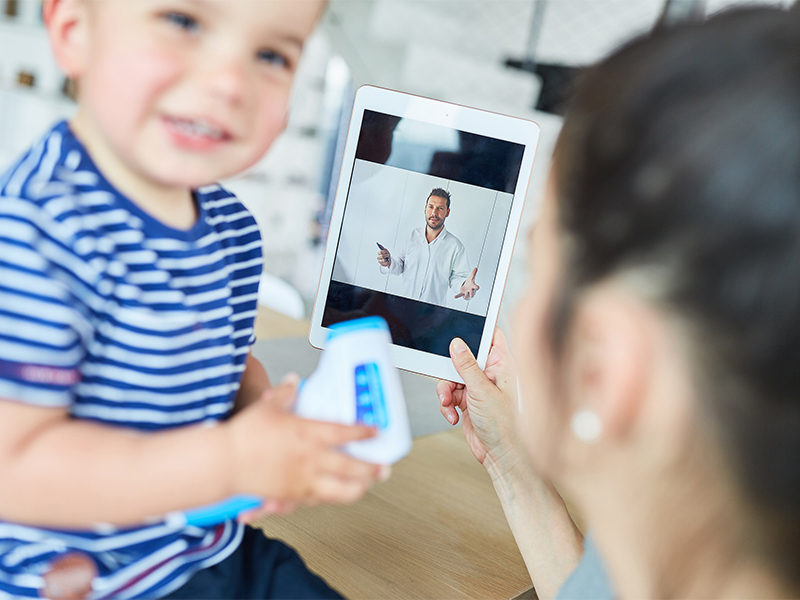When the COVID-19 pandemic began, physicians, therapists and other health professionals quickly pivoted to providing more virtual care to their patients than ever before. Through video and phone visits, they continue to foster relationships with children and their parents, without compromising their efforts for accurate diagnoses.
As the pandemic continues, I encourage parents to feel comfortable with video visits for their children. When pediatricians need to see a child in the office or refer a child to a specialist, we will tell you. And if we can’t pinpoint a specific diagnosis through a video visit, we can guide parents on next steps.
What Doctors Can Do Virtually
Pediatricians are able to diagnose and treat a myriad of conditions through video visits. Consider a video visit for:
- Rashes. If your child has a rash, send the pediatrician photos before your video visit. Once we see the photos up close and get a thorough history, we can usually make an accurate diagnosis and recommend treatment. A picture really is worth 1,000 words!
- Developmental consults. If your infant or toddler isn’t hitting milestones for speech, fine motor skills, gross motor skills or socializing, schedule a video visit. Have your child participate in the visit so the pediatrician can assess the child’s abilities.
- Common colds and upper respiratory symptoms. By seeing your child on video, we can assess congestion, coughing and wheezing. I can pick up the child’s work of breathing in the video to help determine whether the child is in respiratory distress. I can suggest at-home treatments, schedule an in-person exam or direct you to an emergency room.
- Strep throat. This might surprise some parents, but to the delight of children, we can use many clues to determine the likelihood of strep and treat without swabbing the throat! If the child has a headache, abdominal pain, fever and sore throat, pediatricians can prescribe an antibiotic for strep. If the child has congestion and a cough, we recommend a different course of treatment. This protocol, of course, is at the discretion of each provider during the pandemic.
- Eye infections. Photos are helpful in diagnosing eye infections virtually. We can tell whether the diagnosis is pink eye or another infection.
- Ear pain. If symptoms clearly point in the direction of ear infections or teething ear pain, we can often manage the situation virtually. With vague symptoms, the only way to confirm an ear infection is a physical exam.
- Therapy and psychiatry services. Through video visits, many therapists, psychologists and psychiatrists are providing care, helping children deal with feelings of stress, anxiety and other mental health challenges.
When to Visit the Doctor in Person
In some cases, a virtual visit is a good starting point, but we may still need your children to visit their doctor, a specialist or lab. If a child has painful and frequent urination, we’d direct you to a lab for a urine sample. If you suspect a broken bone, we can direct you straight to a radiologist for X-rays. If your child has a laceration, we can look at photos and through a video visit, in most cases, determine whether your child needs stitches.
Of course, sometimes pediatricians do need to see your child in person. With vomiting, we may need to see your child to ensure there’s no belly distension or obstruction. Children experiencing severe respiratory distress should be seen by a physician. Children experiencing severe asthma flares also should come in.
Children feeling chest pain should see a doctor. Fever in infants, particularly in those under 2 months, and infants with fever without any other symptoms would also need an in-office visit.
Of utmost importance is bringing children in for immunizations. During the pandemic, we need to take steps to ensure our children aren’t exposed to illnesses that can, in fact, be prevented. Immunizations protect our children and community from diseases such as measles, mumps, whopping cough, rubella, chicken pox, polio, diphtheria and hepatitis A and B. We also strongly recommend annual flu shots, which during a pandemic are more important than ever for everyone.
Virtual Wellness
Now is a great time to teach children about wellness! While we continue enduring this pandemic, children don’t need to participate in formal, organized wellness programs to reap the benefits. Finding simple ways to practice mindfulness can go a long way toward maintaining a positive outlook and strong mental health.
Look for apps and videos where children can practice yoga and stretching. Also look for child-friendly exercise routines, breathing exercises and meditations. One place to search is the American Academy of Pediatrics’ Healthy Children website, healthychildren.org.
Keep in mind that stepping away from videos and apps is a good idea too. Be sure your child takes time to go outdoors, ride a bicycle, get a good night’s sleep and help others.
These simple steps can make a big difference.

